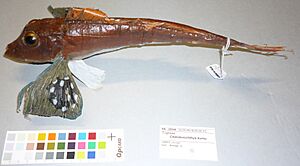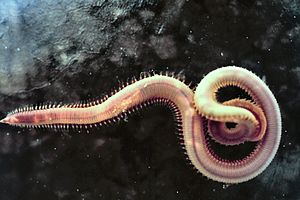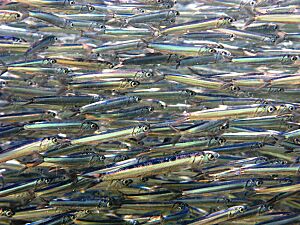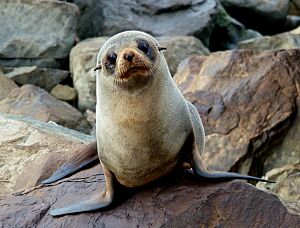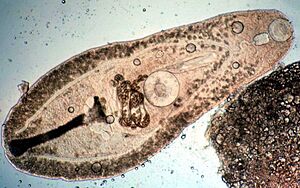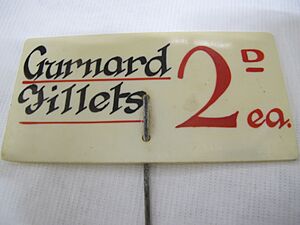Bluefin gurnard facts for kids
Quick facts for kids Bluefin gurnard |
|
|---|---|
 |
|
 |
|
| Conservation status | |
| Scientific classification | |
| Genus: |
Chelidonichthys
|
| Species: |
kumu
|
| Synonyms | |
|
|
The bluefin gurnard or Pacific red gurnard (Chelidonichthys kumu) is a type of ray-finned fish that lives in the ocean. It belongs to the family called Triglidae, which includes gurnards and sea robins. In the Māori language, it is known as kumukumu and pūwahaiau.
You can find this fish in the western Indian Ocean and the western Pacific Ocean. It is very common around Australia and New Zealand. It usually lives in waters up to 200 meters deep. The bluefin gurnard is one of the most important fish caught for food in New Zealand.
Contents
About the Bluefin Gurnard
The bluefin gurnard was first officially described in 1829 by a French zoologist named Georges Cuvier. He found it in New Zealand. The name kumu comes from koumou, which was a local Māori name for this fish in New Zealand.
What Does It Look Like?
The bluefin gurnard lives on the bottom of the ocean. It is famous for its bright red body. It also has large, colorful pectoral fins. These fins have a big black spot in the middle, surrounded by a bright blue edge. When the fish is not stressed, its natural color is a pale brown with spots. It usually turns red when it feels threatened. Its belly is lighter, sometimes even white.
This fish has a boxy, bony head. It has spines pointing backward on its snout and around its eyes. There are also spines on the back edge of its gill cover. Its body is long and gets narrower towards the tail.
The bluefin gurnard has two tall, triangle-shaped fins on its back. It also has large, fan-like pectoral fins. These fins have 13-14 soft rays. The first three rays of its pectoral fins are special. They are separate from the rest of the fin. These rays act like "fingers" that the fish uses to feel the seabed. This helps it find prey hidden in the sand or mud. These amazing fins make the red gurnard look like a butterfly of the sea. They might also help the fish attract a mate or scare away predators. These fan-like fins also help the fish swim steadily.
Where Do They Live?
Around the World
The bluefin gurnard lives in many warm and mild parts of the Indo-West Pacific Ocean. You can often find it along the coasts of New Zealand, Australia, South Africa, and many islands in the South Pacific.
In New Zealand
The bluefin gurnard is the most common gurnard in New Zealand. It lives in all the coastal waters around both the North and South Islands. You can also find it around Stewart Island, the Chatham Islands, and Kermadec Islands. There are many bluefin gurnards in places like the Bay of Plenty, Hawke Bay, Banks Peninsula, and the Foveaux Strait.
Their Favorite Homes
Since it is a bottom-dwelling fish, the bluefin gurnard likes shallow coastal waters. It can be found from the edge of continental shelves to river mouths and even in slightly salty rivers. It prefers soft bottoms made of sand, sandy-shell, or mud. This is because it "walks" slowly over the seabed using its special "fingers." It can also bury itself in the sand or mud. Only the top of its head, nostrils, and eyes are visible. This helps it surprise its prey. While it can be found in waters as shallow as one meter, it usually lives between 100 and 200 meters deep. Sometimes, it can be found as deep as 300 meters.
Life Story
How They Grow
Bluefin gurnard eggs hatch after about 7 days. The young fish grow quickly until they become adults at 2–3 years old. After they become adults, their growth slows down a lot. Older, longer bluefin gurnards are usually found in deeper water.
Male bluefin gurnards are smaller than females. Males are about 26 cm long, while females are about 33 cm. These fish can live for more than 12 years.
When They Lay Eggs
In New Zealand, bluefin gurnards lay their eggs in many places. This happens in shallow and mid-shelf coastal waters around both the North and South Islands. They can lay eggs from spring to autumn, which is from September to May. Females ready to lay eggs have been seen all year round. However, the busiest time for laying eggs is in late spring and early summer, around November and December. The end of their egg-laying season happens when days get shorter and the water gets warmer. These changes might tell the fish when to stop laying eggs. The eggs and young fish grow in the surface waters. Sometimes, young fish can be found in shallow harbors if they are accidentally carried there.
What Do They Eat?
The bluefin gurnard eats whatever it can find. It mainly eats crustaceans like shrimp, prawns, crabs, crayfish, and lobsters. It also eats small fish and worms called polychaete worms. It uses its special fin rays under its pectoral fins to search the sand for food. It might also use its large, fan-like pectoral fins to trick prey into thinking they are safe. You can find them in shallow water with soft ground after winter storms stir things up. They also appear when small shoreline fish like whitebait, anchovy, and pilchard move to different areas.
Along the coasts of Australia, the bluefin gurnard seems to be one of the top predators. It hunts alongside dogfishes, dories, lings, and other flatheads.
One possible use for its large pectoral fins is to make the fish look bigger. This might help scare away other animals that want to eat it.
Who Eats Them? What About Sickness?
We don't know much about what animals eat the bluefin gurnard. However, parts of this fish have been found in the stomachs of fur seals near Banks Peninsula. This shows that fur seals do eat them, but it's not their only food.
The red gurnard can also get parasites. Tiny worms called Nematoda larvae can infect this fish. These larvae, like Anisakis or Contracaecum, can be found in the fish's insides. The parasites found in the bluefin gurnard belong to two main groups: Digenea and Nematoda.
| Group | Species | Where it's found in the red gurnard |
| DIGENEA | Stephanostomum australis | intestine |
| Plagioporus preporatus | intestine | |
| Helicometra grandora | intestine | |
| Tubulovesiculu angusticauda | stomach | |
| Derogenes various | stomach | |
| NEMATODA | Anisakis sp. larva | viscera, mesenteries, under peritoneum |
| Contracaecum sp. larva | two types, in stomach, intestine and body cavity | |
| Ascarophis sp. | stomach | |
| Capillaria sp. | stomach |
Bluefin Gurnard and People
The bluefin gurnard has been a traditional food for Māori for a long time. However, in some parts of New Zealand, people didn't think it was very good to eat. Early European settlers also felt this way. They often sent the fish to Australia, where it was more popular. But by the 1900s, things changed. The bluefin gurnard became one of the most popular fish to eat in New Zealand.
By the 1970s, it was the fourth most caught fish in New Zealand. By the year 2000, about 4,000 tons were caught every year. Even though their numbers were low in the mid-1990s in New Zealand, the population has grown and seems to be staying steady. This fish has tasty, pink, and firm meat with little fat.
The bluefin gurnard is an important fish for fishing businesses in places like Hawke Bay and Golden Bay. They catch it using bottom-trawling nets or long-lines. It's also a common catch for people who fish for fun from boats or from the shore. The National Institute of Water and Atmospheric Research (NIWA) studies bluefin gurnard populations. They do surveys every two years to help the Ministry of Primary Fisheries (MPI) manage fishing. NIWA also talks to people who fish for fun. They ask where fish were caught, how big they were, and what bait was used. This helps them learn more about the fish populations. The legal size for catching a bluefin gurnard is 25 cm.
What Sounds Do They Make?
Bluefin gurnards are known to be quite noisy when they are caught. They make loud grunting sounds. These sounds are not made by vocal cords like humans. Instead, they are thought to be made by special muscles that vibrate a part of the fish called the swim bladder. The growling sound is made at night by single fish. The grunting sound is made when the fish are grouped together. Grunts last about 0.2 seconds and can be heard easily. Their sound frequency is between 250 and 300 Hz. The bluefin gurnard is believed to be the loudest fish in its family, the Triglidae.
One study of a female red gurnard in captivity found that it could make four different types of sounds. These sounds fell into two main groups: grunt and growl. It made sounds every hour, all day and night, with more sounds at dawn and dusk. Growls were made at night. The sounds were not linked to feeding. It's thought that these sounds might be related to breeding. They are known to make the most noise during their breeding season. These sounds are likely a big part of the underwater noise where they live.



